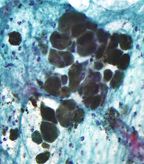Altered Dosing of Vemurafenib Could Delay or Prevent Resistance
Researchers using a mouse model of melanoma were able to prevent resistance to vemurafenib by altering the dosing schedule from a continuous daily dose to an intermittent dose.
In a new study published today in Nature, researchers using a mouse model of melanoma were able to prevent resistance to vemurafenib by altering the dosing schedule from a continuous daily dose to an intermittent dose, suggesting a possible way to prolong the onset of resistance for melanoma patients.

Micrograph of pigmented malignant melanoma; source: Nephron, Wikimedia Commons
Vemurafenib (Zelboraf), a small-molecule kinase inhibitor, is the first targeted therapy approved by the US Food and Drug Administration for metastatic melanoma, approved for tumors that express the BRAF V600E gene mutation. Resistance to the drug, however, is problematic, with the vast majority of patients experiencing tumor regrowth several months into treatment.
Martin McMahon, PhD, of the Helen Diller Family Comprehensive Cancer Center at the University of California San Francisco (UCSF), and colleagues at the Novartis Institutes for Biomedical Research in Emeryville, California found mouse models that become resistant to vemurafenib with chronic exposure have a continued dependency on the BRAF-MEK-ERK signaling pathway. The vemurafenib-resistant tumor growth that develops is actually dependent on the drug. When the drug administration was stopped, tumor regression was observed within 10 days, followed by tumor regrowth. “These data support the hypothesis that vemurafenib-resistant tumors suffer a fitness deficit in the absence of vemurafenib,” the authors conclude.
“Intermittent dosing alternates the selective pressure applied by drug treatment and prevents the evolution of a drug-resistant state,” said Darrin Stuart, PhD, a senior investigator at the Novartis Institutes for Biomedical Research and one of the lead authors of the publication.
The resistance mechanism detected was upregulation of BRAF rather than mutations within BRAF or other genes in the signaling pathway.
“Even cancer cells are sensitive to the level of oncogenic pathway activation such that too little or too much of a pathway to which a cancer cell is addicted can be deleterious to the cell. This phenomenon is known as the ‘Goldilocks effect’,” explained McMahon.
The results may have major implications for the way targeted therapies against active protein kinases are administered. “The current paradigm for oncoprotein kinase directed therapy is continuous administration-this data hints that continuous therapy may not always be the best approach,” said McMahon.
The problem is not an easy fix-physicians need to balance maximal tumor regression, typically achieved by continuous treatment, and delaying the onset of resistance, which this study suggests might best achieved with an intermittent drug dose.
Mice given vemurafenib continuously on a daily basis developed resistance within 100 days of treatment initiation. In contrast, those mice treated for their melanoma intermittently with a 4 weeks on, 2 weeks off regimen did not develop resistance by day 200 of treatment.
It is not yet possible to identify patients whose tumors are dependent on chronic vemurafenib exposure, said McMahon, but “devising such a test is feasible and ongoing.”
“There is evidence that patients with drug-resistant disease experience tumor regression when dosing is suspended, however, the therapeutic approach to test would be to use intermittent dosing from the beginning and not wait until resistance emerges,” said Stuart.
McMahon noted that there is considerable interest at the UCSF Melanoma Clinic to test whether an intermittent dose schedule of vemurafenib and other BRAF V600E inhibitors may increase the duration of responses. “The idea is now out in the clinical community and so fair game for anyone to design an appropriate clinical trial,” said McMahon. Still, more laboratory research is warranted to understand how frequently this type of phenomenon occurs and how too much BRAF V600E activity inhibits the proliferation of melanoma cells addicted to BRAF V600E signaling, said McMahon.
It is possible that changing the dosing schedule of other oral kinase inhibitors could also delay drug resistance in many other tumor types but much more research, both clinical and laboratory, is necessary.
Multiple clinical trials to test alternative dosing regimens of BRAF and likely other targeted, oral inhibitors are expected over the next few years according to Stuart. Exploring rational drug combinations is another approach that Novartis is taking.
The current study is a public–private sector collaboration between UCSF and the Novartis Institute for Biomedical Research with “a free-flow of information between the two groups as well as open sharing of materials and reagent,” said McMahon. McMahon added that testing the effects of intermittent doses of BRAF inhibitors would likely also be part of such a public–private sector partnership.